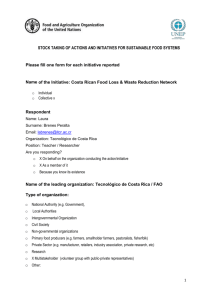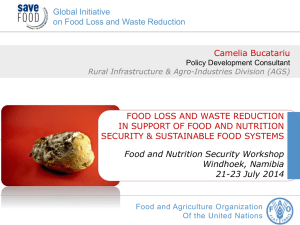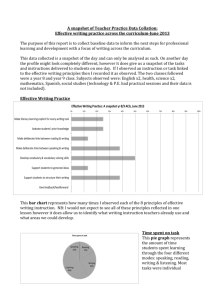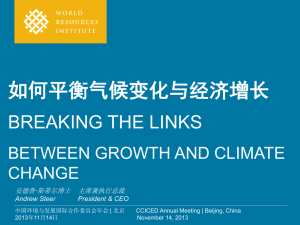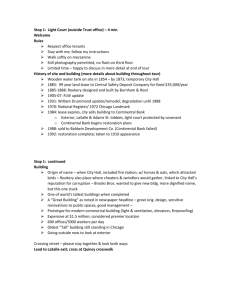FLW Standard Feedback Form
advertisement
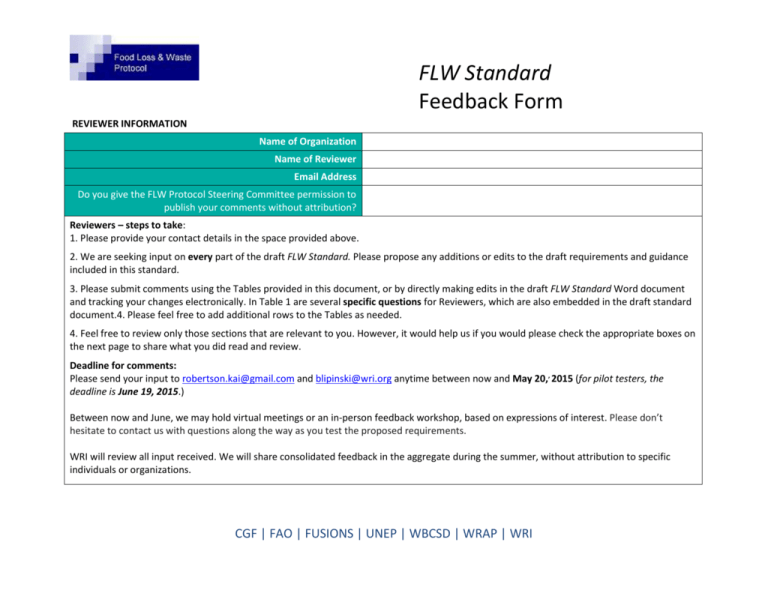
FLW Standard Feedback Form REVIEWER INFORMATION Name of Organization Name of Reviewer Email Address Do you give the FLW Protocol Steering Committee permission to publish your comments without attribution? Reviewers – steps to take: 1. Please provide your contact details in the space provided above. 2. We are seeking input on every part of the draft FLW Standard. Please propose any additions or edits to the draft requirements and guidance included in this standard. 3. Please submit comments using the Tables provided in this document, or by directly making edits in the draft FLW Standard Word document and tracking your changes electronically. In Table 1 are several specific questions for Reviewers, which are also embedded in the draft standard document.4. Please feel free to add additional rows to the Tables as needed. 4. Feel free to review only those sections that are relevant to you. However, it would help us if you would please check the appropriate boxes on the next page to share what you did read and review. Deadline for comments: Please send your input to robertson.kai@gmail.com and blipinski@wri.org anytime between now and May 20,, 2015 (for pilot testers, the deadline is June 19, 2015.) Between now and June, we may hold virtual meetings or an in-person feedback workshop, based on expressions of interest. Please don’t hesitate to contact us with questions along the way as you test the proposed requirements. WRI will review all input received. We will share consolidated feedback in the aggregate during the summer, without attribution to specific individuals or organizations. CGF | FAO | FUSIONS | UNEP | WBCSD | WRAP | WRI FLW Standard Feedback Form SECTIONS READ BY REVIEWER/PILOT TESTER Please check the appropriate boxes to share what you did read and review. If you read a chapter and had no comments, we would nonetheless like to know if you read it. Chapter Chapter 1. Chapter 2. Chapter 3. Chapter 4. Chapter 5. Chapter 6. Chapter 7. Chapter 8. Chapter 9. Chapter 10. Chapter 11. Chapter 12. Chapter 13. Introduction Why prepare a FLW inventory and report Summary of steps and requirements Accounting and reporting principles Establishing the scope of a FLW inventory Deciding how to quantify FLW Data collection and calculation Coordinating development and analysis of multiple FLW inventories Recording causes of FLW Review and assurance Reporting Setting targets and tracking changes over time Detailed guidance on methods for quantifying FLW Which methods did you read? (please list) Chapter 14. Analyzing FLW data Did you read this chapter? (Please check if yes) ☐ ☐ ☐ ☐ ☐ ☐ ☐ ☐ ☐ ☐ ☐ ☐ ☐ List: ☐ CGF | FAO | FUSIONS | UNEP | WBCSD | WRAP | WRI FLW Standard Feedback Form SPECIFIC QUESTIONS FOR REVIEWERS Please submit comments using either the table below, or by directly making edits in the draft FLW Standard Word document and tracking your changes electronically. This table includes several specific questions for Reviewers, which are also embedded in the draft FLW Standard document. Table 1. Section Outstanding Questions General If a FLW inventory accounts for and is based on the requirements outlined in the FLW Standard, does this provide sufficient transparency about the extent of FLW to meet your decision-making needs? If not, please describe what would need to be added or changed? Comments Part II: Preparing to quantify General For pilot testers only, Please share any challenge you encountered in reporting the scope of the inventory boundary (Tab II of the spreadsheet). Section 5.4 (Timeframe) The standard requires quantifying FLW over the course of one year. Are there situations where this would not be feasible? For example, in agricultural production there are harvest seasons of several months. However, since the data is still based on looking across a full year, wouldn’t the reporting period still be one year? If a 12-month timeframe is not feasible, please provide an example and why this timeframe does not work and present an alternative suggestion. CGF | FAO | FUSIONS | UNEP | WBCSD | WRAP | WRI FLW Standard Feedback Form Section 5.5.2 (Material type) a. [Regarding cases in which it may not be known from the outset whether or not a substance will be destined for food and this intention may change as a substance proceeds along the food supply chain.] Please share any additional approaches that could be included or if you know of other individuals who may have relevant suggestions. b. A general request is to please share any other thoughts, rules of thumb or examples that could be included in the section above. How would a business (or industry) determine what is “intended?” Could that be shared, or is it proprietary? We recognize that this area in particular may benefit from additional research. It is not part of the scope of the FLW Protocol to undertake additional research of this type currently but we welcome additional thoughts and input on research that may be needed in order to help an entity quantify FLW. Section 5.7.1 (Boundary) a. Please provide feedback on your ability to use the classification sources referenced in Table 5.3. Ideally, there is one globally applicable classification for each dimension but this may not be practically feasible. b. Can you use the GSFA codes and fulfill this recommendation to at least report based on those codes? If so, does it provide useful information? If not, please describe the limitations of the GSFA and an alternative suggestion.] c. Is this guidance about multi-ingredient items necessary to include? And if so, is this suggestion clear? Can it be implemented? d. Please share if you are aware of a classification system that might be useful for the “organization” dimension, or have recommendations for a way to describe this dimension more consistently across FLW inventories. CGF | FAO | FUSIONS | UNEP | WBCSD | WRAP | WRI FLW Standard Feedback Form Section 5.8 a. a. If water is added to FLW, are you able to quantify the FLW without the (Additional added water (see Chapter 13.12 for guidance on quantification options)? considerations) b. If the intrinsic water is removed from FLW, can you report the weight of FLW before the intrinsic water was removed as required? If not, can you report the weight after the intrinsic water was removed? General The destination categories are intended to be as mutually exclusive as possible such that, for any one reporting entity, there is no double counting of FLW between categories. How close are we to achieving this? Part III: Important Concepts for Quantification Section 7.3.4 (Determining appropriate sample size) Would it be useful to include an example sample size formula here, or include reference to a resource? Section 7.5.2 (Guidance on conversion factors) We recognize that this area in particular may benefit from additional research as the definitions of inedible and percentages provided in existing databases may not be adequate for the needs of entities seeking to identify separately “inedible parts.” It is not part of the scope of the FLW Protocol to undertake additional research of this type currently however we welcome additional thoughts and input on research that may be needed in order to help an entity quantify FLW. Section 8.3 (Guidance on specifying scope, quantification methods, and Please provide input on Box 8.1 about the sample scope a national authority could specify for entities preparing FLW inventories. CGF | FAO | FUSIONS | UNEP | WBCSD | WRAP | WRI FLW Standard Feedback Form assumptions) Part IV: Guidance on Quantification Methods General For ALL of the methods described in Chapter 13, please provide any suggested changes or additions. These sections are based on initial input by members of the Technical Working Group but will benefit from further refinements. Additional examples to elaborate on guidance provided are also welcome. Section 13.5.5 (Guidance on implementing the “assessing volume” method) (1) Please comment if this table is useful. (2) Bulk density factors are only provided in Table 13.3 for certain types of containers and no factors are listed for ‘uncontained’ or ‘vehicles,’ or for other types of containment. Please provide suggestions for other factors to include – and provide the reference source. Section 13.6.1 (Overview of the “waste composition analysis” method) Please let us know if you are familiar with the American Society for Testing and Materials (ASTM) guidelines and whether they apply to FLW as well. Section 13.9.5 (Guidance on implementing the “mass balance” method) Does this figure help explain mass balance to you? If not, please suggest improvements – or whether it should be deleted. Section 13.12.2 Is the “drying and weighing” approach one that you would (or could) apply? CGF | FAO | FUSIONS | UNEP | WBCSD | WRAP | WRI FLW Standard Feedback Form (Using a “drying and wetting” approach) If not, why not? Section 14.1 (Introduction to analyzing FLW data) Weighting FLW data is another step undertaken as part of analyzing data (see Section Error! Reference source not found., for example). Would it be useful to include general guidance on how to weight data? In addition, would you recommend any other ways to analyze FLW data that would be useful to a user of the FLW Standard? If you have recommendations, please share any suggested text or relevant experts who may be able to provide further input. Section 14.5.1 – (Uncertainty) Please provide feedback on the recommendation of a 10 point scale where 1 is “best guess” and 10 is “very accurate.” In general, have we covered all the ways in which to quantify FLW where water has been added? Not all users will be able to quantitatively assess the uncertainty of FLW data. This scale is therefore proposed as one way all users could report on the estimated degree of uncertainty. We are seeking input on suggestions for ways in which to ensure that users reply more consistently to specific points on the scale of 1 through 10 (e.g., so that there is more consistency between what, for example, qualifies as a “3 response” versus a “5 response.”) CGF | FAO | FUSIONS | UNEP | WBCSD | WRAP | WRI FLW Standard Feedback Form Appendix General The guidance for the Appendix on quantifying donations has not yet been drafted. If you are interested in providing input on this, please let us know. General The guidance for the Appendix on “converting weight to other units of analysis” has not yet been drafted. you are interested in providing input on this, please let us know. CGF | FAO | FUSIONS | UNEP | WBCSD | WRAP | WRI FLW Standard Feedback Form OVERALL REVIEW Please feel free to provide any additional comments as a bulleted list (e.g., in Word or in an email), in track changes, or to use the table below. Table 2. Chapter Line number Subsection/ Figure/ Table/ Type of comment: general, technical, editorial Comments CGF | FAO | FUSIONS | UNEP | WBCSD | WRAP | WRI Proposed change FLW Standard Feedback Form FEEDBACK ON EXCEL INVENTORY REPORTING TEMPLATE We would also greatly appreciate feedback on the draft Excel-based Inventory Reporting Template. We would like to make the Template as user-friendly and self-explanatory as possible. We are therefore interested in comments on the overall ease of use of the Template, as well as comments pertaining to specific tabs/cells that would improve it. Please feel free to provide your comments as a bulleted list (e.g., in Word or in an email), in the Excel directly, or in the table below. You are not required to return the inventory reporting template to WRI. However, if you are comfortable sharing your sample, it would help us better understand your input. All information shared will be held confidential and not distributed outside the FLW Protocol team at WRI. IF you answered “other” in the destination scope, please share what this was. Tab # (e.g., Intro, I, II, III…) Cell number Type of comment: general, technical, editorial, functional Comments Proposed change CGF | FAO | FUSIONS | UNEP | WBCSD | WRAP | WRI
